Introduction
Endeavour Energy serves some of Australia’s largest and fastest growing regional economies. Endeavour Energy owns, develops, operates and maintains electricity distribution assets in NSW, and is subject to the National Electricity Law (NEL) and National Electricity Rules (NER) administered by the Australian Energy Regulator (AER).
The NER require all registered DNSPs to:
- Conduct an annual planning review and publish a DAPR;
- Conduct economic assessments of potential project options under the RIT-D; and
- Implement a Demand Side Engagement Strategy to consult with and engage non-network providers in the development and evaluation of potential solutions to identified network needs.
The annual planning review includes the planning for all assets and activities carried out by Endeavour Energy that would materially affect the performance of its network. This includes planning activities associated with replacement and refurbishment of assets and negotiated services. The objective of the annual planning review is to deliver asset management plans which are designed in the long-term interest of customers. The planning review is also intended to identify possible future issues that could positively and negatively affect the performance of the network to enable Endeavour to plan for and adequately address such issues in an appropriate timeframe. This DAPR reflects the outcomes of Endeavour Energy’s 2022 annual planning review.
Endeavour Energy is required to prepare and publish a DAPR that complies with the requirements of the NER Schedule S5.8 Distribution Annual Reporting Requirements to:
- provide transparency of Endeavour Energy’s decision-making processes and provide a level playing field for all stakeholders in the national electricity market in terms of attracting investment and promoting efficient decisions
- include information associated with all parts of the planning process including forecasting demand, identification of network needs and the development of credible options to address network limitations
- to give third parties the opportunity to offer alternative proposals to alleviate constraints. These proposals may include non-network options such as demand management or embedded generation solutions
- set out the results of Endeavour Energy’s annual planning review, including joint planning, covering a minimum five year forward planning period for distribution assets
- inform registered participants and interested parties of the annual planning review outcomes including asset retirement and network capacity needs for sub-transmission lines, zone substations and transmission-distribution connection points and any primary distribution feeder capacity needs that exist or are expected to emerge within the next two years
- provide information on Endeavour Energy's demand management activities and actions taken to promote non-network initiatives each year including plans for demand management and embedded generation over the forward planning period, and
- assist non-network providers, TNSPs, other DNSPs and connection applicants to make efficient investment decisions.
The DAPR covers a minimum five year forward planning period for distribution network sub-transmission assets.
About Endeavour Energy
We power our customers lives and businesses and support the economic and liveable urban develop of our regions including Greater Western Sydney. Our enduring focus is providing affordable, safe, resilient, sustainable and reliable electricity to the 2.7 million people across our network, and 2.8 million by 2029.
Endeavour Energy plans, builds, operates and maintains the poles and wires and other distribution assets to provide an affordable, safe and reliable power supply to and from households and businesses across Sydney’s Greater West, the Blue Mountains, Southern Highlands, the Illawarra and the South Coast.
The timely and efficient provision of these services is fundamental to supporting employment growth, economic development and housing affordability across one of the fastest growing metropolitan and regional economies in Australia.
Our network services communities with some of the highest cultural and language diversity in Australia across the lands of the traditional custodians – the people of the Dharawal, Dharug, Gundungarra, Wiradjuri and Yuin nations. We recognise first peoples’ continuing connection to Country, cultures and community. We pay our respect to elders past and present.
Over the next 20 years, these areas will be home to communities similar in size to Canberra. The population of Western Sydney is expected to increase by 1,00,000 by 2036 and we expect more than 20,000 new customers will connect to the network each year.
With change comes the opportunity for accelerated technological adaption, and so we welcome partnerships with government, universities and energy innovators to find new ways to optimise the use of network services to unlock value for customers.
Endeavour Energy’s network
In 2021/22, Endeavour Energy’s network supplied 16,711 GWh of electricity to 1,082,919 network connected customers. The bulk of Endeavour Energy’s supply of electricity from traditional sources is taken from the generation source through TransGrid’s transmission network at 132kV and 66kV. When the energy is transferred into Endeavour Energy’s network, the voltage is transformed through 36 sub-transmission and 171 zone substations and distributed to customers through a 22kV, 11kV or 12.7kV high voltage network. Distribution substations further reduce the voltage to supply customers with a 230V nominal low voltage supply in accordance with Australian Standards. Increasingly, Endeavour Energy’s network is accommodating the rapid uptake of residential and industrial scale solar generation, and embedded customer, community and industrial batteries, microgrids, virtual power plants and electric vehicle charging infrastructure.
Endeavour Energy statistics as at 30 June 2022
| Statistic | Number |
|---|---|
| Distribution Customer Numbers (total) | 1,082,919 |
| Maximum Demand (aggregated system MW) | 3,716 |
| Energy Received by Distribution Network to Year End (GWh) | 14,819 |
| Energy Distributed to Year End (Residential) (GWh) | 5,765 |
| Energy Distributed to Year End (Non-Residential Including un-metered supplies) (GWh) | 10,947 |
| Energy Distributed to Year End (GWh) | 16,711 |
| System Losses (%) | 4.2 |
| Transmission Substation (Number) | 36 |
| Zone Substation (Number) | 185 |
| Bulk Supply Point (Number) | 15 |
| Distribution Substation (Number) | 33647 |
| Sub-Transmission Overhead (km) | 3003 |
| Sub-Transmission Underground (km) | 421 |
| High Voltage Overhead (km) | 11,240 |
| High Voltage Underground (km) | 5,768 |
| Low Voltage Overhead (km) | 8,583 |
| Low Voltage Underground (km) | 10,608 |
Our business is changing fast. What was once a network of poles and wires delivering one-way electricity supply to customers is rapidly evolving into a multi-directional system, where DERs feature, and allow our customers to send excess power back into the grid.
The uptake of rooftop solar by Endeavour Energy’s customers is unprecedented. In 2010, there were 24,430 solar systems on rooftops. Now there are over 220,000 systems connected to the network with large, industrial solar an increasing feature across Western Sydney.
Local councils across our area have also flagged significant interest in community batteries, electric vehicle charging stations, smart street lighting, community solar gardens, microgrids and the need for a more resilient network in the face of climate change. These interests require significant changes to the way we plan for the network of tomorrow. Rapid technological change, shown in
Below image poses both significant opportunities as well as challenges for Endeavour Energy to manage the safe, affordable and reliable integration of all these distributed energy resources in the network.
If properly managed, solar and storage systems can work together to support the grid, reducing the need for investment in poles and wires infrastructure, and ultimately saving customers money on power bills.
Electricity Network Transformation - past, present and future
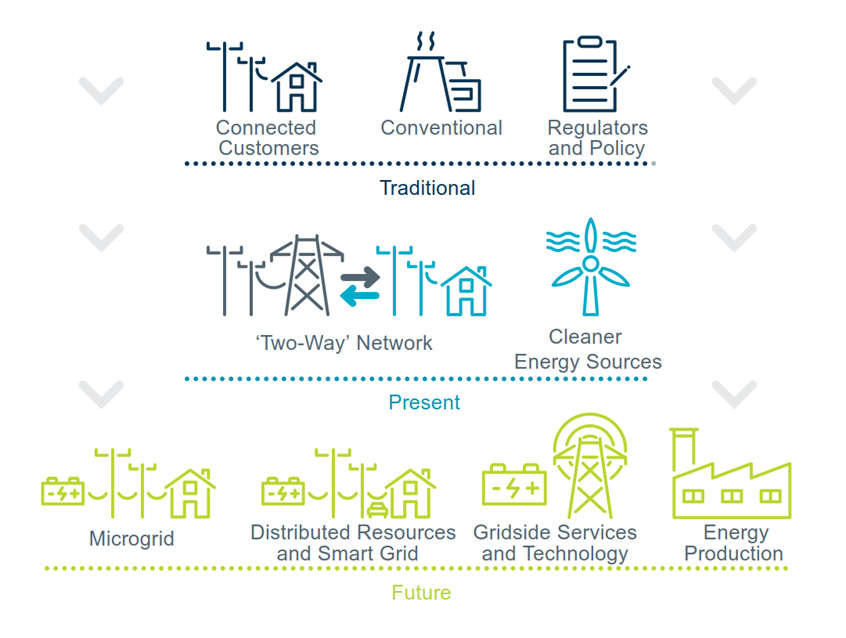
To help plan for these changes, Energy Networks Australia invited customer advocates and energy industry stakeholders to help the CSIRO map out a plan called the Electricity Network Transformation Roadmap.
Endeavour Energy’s leadership chaired the group that designed the Roadmap and is committed to its implementation. More recently, the NSW Government has consulted with Endeavour Energy to ensure the smooth implementation of the NSW Government’s Electricity Infrastructure Roadmap, which will see the development five renewable energy zones across NSW, with one in the Illawarra region.
Also, The Energy Security Board (ESB), in collaboration with the Australian Energy Market Commission (AEMC), the AER and other market bodies, is transitioning the NEM into a modern energy system fit to meet consumers’ evolving wants and needs. The ESB proposed a suite of reforms to meet the needs of this transition. With all the reforms in place, the NEM will allow consumers to benefit from rapidly changing technologies in power system; unlock the value of flexible demand and distributed energy resources; and provide clear signals for timely and efficient investment to deliver reliable, secure, and affordable electricity for consumers.
Operating environment
Endeavour Energy is 50.4 percent owned by an Australian-led consortium of long-term investors in the private sector operating the network under a 99-year lease. The private sector consortium comprises of funds and clients managed by Australia’s Macquarie Asset Management, Canada’s British Columbia Investment Management Corporation and Qatar Investment Authority.
The remaining 49.6 percent is held by the State of NSW via a corporation constituted under the Electricity Retained Interest Corporations Act 2015.
This change in ownership in 2017 means we continue to leverage the vast infrastructure management experience of the consortium to transform our business into a world class utility, delivering further improvements in safety, operating efficiency and customer service outcomes.
Our customers are central to our plans. We’re committed to making a serious and sincere effort to deliver the best value for customers by reducing our costs, without compromising safety or services.
Endeavour Energy is regulated by statutory and legislative requirements including work, health & safety (WH&S), environmental, competition, industrial, consumer protection and information laws, the NEL, the NER, the NSW Electricity Supply Act 1995 and the requirements of its NSW Distribution Network Service Provider licence. Endeavour Energy complies with these laws and regulations through its internal policies, procedures, workplace instructions and industry codes and standards. We operate a common business control framework across these various instruments that allows us to fulfil our obligations through the development and implementation of plans, delegations of authority and associated controls, instruction and training, audits of compliance, and risk identification and management.
In particular, Endeavour Energy’s operations are guided by a number of important policies and codes, including a Code of Conduct, a Stakeholder Engagement Framework, our Safety Policy, Environmental Code of Conduct and our Statement of Business Ethics.
Endeavour Energy is managed by a Board of Directors and a Chief Executive Officer (CEO). Endeavour Energy’s CEO reports to the Board. The Board is responsible for setting the overall strategic direction and performance targets and monitoring the implementation of the strategy by the organisation. The CEO leads the Executive Leadership Team in delivering the approved strategy and achieving the performance targets set by the Board.
Within NSW, the Network Reliability and Performance Licence Conditions are imposed by the Minister of Energy. The Independent Pricing and Regulatory Tribunal (IPART - Electricity) is responsible for administering licensing within the energy industry and monitoring compliance with licence requirements on request from the Minister. Safety performance and compliance is also administered by IPART in conjunction with WorkCover NSW. The AER is the economic regulator of the distribution and transmission sectors of the NEM under the NEL and NER.
There are significant costs in building and maintaining a distribution network of our size and complexity. Our core activities include:
- Safely maintaining distribution lines and substations to keep the lights on
- Building new substations, poles and wires, including in new suburbs
- Responding to emergencies like storms which bring down power lines and poles
- Tree trimming to maintain safety clearances, manage bushfire risk and prevent blackouts caused by falling trees
- Facilitating the connection of new customers to the network
- Researching, trialling, and installing new technology, like batteries, to use as alternatives to poles and wires
- Installing and maintaining streetlights
- Various ‘user pay’ services like meter testing, off-peak conversion and design certification.
Our Values
Endeavour Energy employees are required to understand and support Endeavour’s corporate values. These five values and their associated behaviours are the basis for everything we do.
Put safety first. Care. Always. |
Listen. Share goals. Work together as one. |
Stretch for excellence. Innovate. Challenge ourselves. Create value. |
Be nimble and flexible. Be open to learn. Embrace opportunities. |
Do what you say and own the impact of what you do. See it through. |
Our strategy
Our primary goal is fundamental and enduring; to ensure our customers have reliable access to an electricity network that is affordable, safe and sustainable, and that enables access to power in a way that suits the lifestyle and energy needs.
We work together to adapt quickly to the needs of our customers and continually strive to find better ways to power our communities.
Our corporate strategy supports the principles of the Energy Charter and is designed to promote the long term interests of our customers, shareholders, people and communities by delivering five strategic goals set out in our strategy house, below.
Our Strategy House
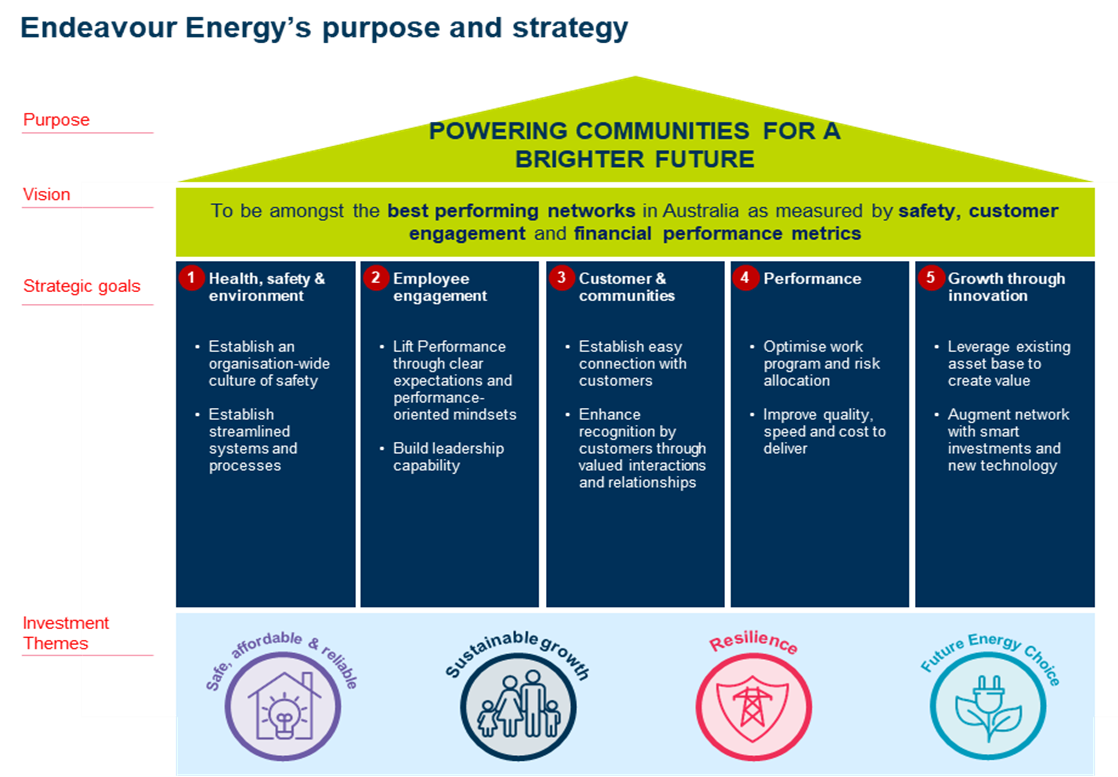
Our Customers
We serve a diverse population with over 1 million customers across 24,980 square kilometres. Most of our customers are households and small to medium businesses located in urban and developing rural areas. We also serve large urban areas, medical precincts and manufacturing and industrial customers who have specific needs for a safe and reliable supply, and we provide high voltage support directly to very large businesses.
Our network includes significant development areas such as the Western Parkland City and the Western Sydney International (Nancy-Bird Walton) Airport and its surrounding aerotropolis. It’s also home to Sydney’s North West, South West and Greater Macarthur Priority Growth sectors, planned as new release areas to house communities similar in size to Wollongong and Canberra. By 2036, half of Sydney’s population will be expected to reside within Sydney’s west with an additional 725,000 dwellings projected. In addition to population growth, our customers have the third highest energy density and demand density in the NEM. This means that our customers consume a relatively high amount of energy, particularly during peak times (4pm to 8pm). This is largely due to a combination of higher summer temperatures (often up to 10 degrees higher than the Sydney CBD) and energy-intensive economic activity.
As the electricity industry undergoes rapid transformation, many customers are changing the way they interact with the network and we are seeing more small-scale renewable forms of generation connecting to the network. By June 2022, approximately 225,000 customers had connected their own small scale renewable generation (mostly solar panels) to the network, representing a cumulative capacity of around 1GW. Our network will continue to play a critical role in enabling a range of customer benefits from the increasing uptake of distributed energy resources (DER). In Chapter 4, we provide more detail on the way our customers consume and produce energy is evolving.
Endeavour Energy is a signatory to the Energy Charter, an industry and customer led, world-first, whole-ofsector initiative to address customer expectations. Endeavour Energy works to deliver the five principles of the Energy Charter:
- We will put customers at the centre of our business and the energy system
- We will improve energy affordability for customers
- We will provide energy safely, sustainably and reliably
- We will improve the customer experience
- We will support customers facing vulnerable circumstances
Our Regions
We manage our operations over three distinct geographic regions:
NORTHERN REGION (NORTH-WEST SYDNEY AND BLUE MOUNTAINS – WIRADJURI AND DHARUG NATIONS)
Most of our customers (and our network infrastructure and assets) are located in Greater Western Sydney which includes the major cities of Parramatta, Blacktown, Penrith, along with the Hawkesbury and the Hills regions located in the Northern region. Combined with other major centres in the Central region, they form the third largest economy in Australia.
Typical of urban expansion, greenfield development within Sydney is largely confined to regions on the city fringe. This suburban development has been primarily driven by the largest coordinated land release in the history of NSW. Development to accommodate this expansion has been concentrated in the North-West and South-West Sydney regions which are entirely captured by our network area. With half of Sydney’s population expected to reside within Sydney’s west within the next 15 years, our investment plans for the next regulatory period support required growth in these areas.
We also supply customers throughout the Blue Mountains and beyond. This is a World Heritage Area featuring dense vegetation with challenging topography. Managing bushfire risk and reliability is a key focus for this part of our network.
CENTRAL REGION (SOUTH-WEST SYDNEY AND SOUTHERN HIGHLANDS –GUNDUNGURRA, DHARUG AND DHARAWAL NATIONS)
The central area of our network incorporates the major urban centres of Liverpool, Fairfield and Campbelltown. In common with the Northern region, strong greenfield growth has been experienced in areas that were previously low-density rural communities. Large transport infrastructure investments underpin population and economic growth in the area.
This area is also home to Sydney’s second international airport at Badgerys Creek, featuring development of an ‘aerotropolis’. Set to open in late 2026, we are working closely with planning authorities and developers to support this and other planned development in the surrounding area.
South-west of the Sydney metropolitan region, the rural townships of Picton, Bowral, Mittagong and Moss Vale form the major regional communities of the Southern Highlands.
SOUTHERN REGION (ILLAWARRA AND THE SOUTH COAST – DHARAWAL AND YUIN NATIONS)
Most of our resources in the Southern region are focused in Wollongong and the wider Shellharbour district. After Sydney and Newcastle, Wollongong is NSW’s third largest city and is home to approximately 300,000 people. Significant growth is planned for the region, led by the West Lake Illawarra area which will ultimately accommodate an estimated 38,000 new dwellings. This region includes Port Kembla Harbour and an industrial complex that is the largest single concentration of heavy industry in Australia.
The most southern areas of our network are predominantly small coastal communities, popular with holiday tourists and retirees, and often subject to severe weather events. Our growth story extends to this area too, with an estimated 5,000 new homes possibly in the greenfield Moss Vale Road Urban Release Area in the Shoalhaven region.
Never before has the community been so focused on the affordability, reliability and security of their electricity services as the energy industry in Australia undergoes a dramatic transformation. We’re committed to efficient investment and giving customers more choice and control.
The challenges to providing a safe, reliable and affordable service are evolving as the NEM is impacted by decarbonisation, decentralised generation and changing energy consumption patterns. We must evolve to keep pace with these trends in order to meet the expectations of our customers into the future.
There are key trends shaping our current and future operational landscape. These are:
- Customer centrality: A focus on customers’ needs and experiences from high energy users to pensioners to empowered prosumers means customers play a more central role in the operation of the network as networks evolve to be platforms of energy services. Underpinned by new technologies, customer expectations and service needs will evolve. Customers will expect to help shape the direction of the business through deep engagement on regulatory proposals and beyond.
- Trust, reputation and purpose: The reliable delivery of an affordable crucial service underpins trust and is core to our purpose. Customers also increasingly expect organisations to align with personal and community values for environmental and social governance (ESG). Purposeful decision making, with an emphasis on ESG outcomes, will be essential to retain social licence, attract investment, and to establish and maintain a high-performance culture.
- Western Sydney regional growth: The NSW Government is driving the substantial and rapid growth of Western Sydney, at a rate nearly 40% higher than the rest of Metropolitan Sydney. By 2036, half of Sydney’s population will reside within the city’s west, supporting a new airport, new industry and manufacturing, and a new science park. This plan is akin to building a new city, from scratch.
- Economic volatility and cost of living pressures: International and domestic developments have contributed to rapidly rising inflationary pressures, including in energy prices, with rising concerns about a possible slowdown in the Australian economy. Cost of living pressures are increasingly centre of mind now for all customers small and large. Transitioning the grid to ensure long term value for money services as customers make increasing energy choices in the most efficient way requires balancing in the short and long-term.
- Climate change and extreme weather events: Climate modelling suggests that extreme weather events will continue to increase in both frequency and intensity over the coming decades. Climate change-related events damage, destroy and/or compromise the performance of infrastructure, and increase risks to the reliable supply of electricity.
- A changing grid in a low carbon economy: The pursuit of a net zero economy will transform the way we generate and consume energy. As customers take up technologies such as solar, batteries and electric vehicles, the network will need to evolve to allow for two-way flows and active participation from customers and third parties. Over time, more sophisticated digital platforms will seek to interact with a more dynamic, integrated network that orchestrates the low carbon energy system.
- Efficient and effective service in the digital age: Introduction of digital technologies and enhanced data capabilities create significant operational efficiencies, while transforming the risk, roles, required skills and location of the future workforce. At the same time, cyber-attacks become more frequent and sophisticated, targeted at the disruption of energy supply.
Western Sydney regional growth
NSW population industrial growth has focused on the urban expansion of Sydney’s Greater West. This strategic expansion will drive the substantial and rapid growth of the region, at a rate nearly 40% higher than the rest of Metropolitan Sydney. By 2036, half of Sydney’s population will reside within the city’s west, centred around new ‘satellite cities’. Projections suggest the need for an additional 725,000 dwellings, in a region that is also planned to cater for a new airport, new industry, rejuvenation of manufacturing, and a science park. We will be part of building a new city, from scratch.
Endeavour Energy is responsible for the expansion of the distribution network to facilitate this growth and industry, and to support the NSW Government’s planning and development of liveable, productive and sustainable communities that thrive. This focus has been a driver of our investment for several years and it will continue to be in the foreseeable future. To continue to accommodate this growth, new networks must be planned and delivered in a way that both facilitates this vision and futureproofs the network. For residents, small and large business and emerging needs such as datacentres and hydrogen hubs. This requires a focus on:
- Planning for the future: This predicted expansion of the asset base is occurring at the same time as the changing nature of the grid. Endeavour Energy will need to work with developers and government to ensure greenfield developments are future-proofed, efficient and remain cost-effective.
- Ensuring network infrastructure is not a barrier to growth: The roll-out of new infrastructure across Western Sydney will require significant investment, and the expansion cannot occur without this supporting infrastructure in place. Endeavour Energy will need to work with the Government to ensure the infrastructure expansion meets the growth of the of the community.
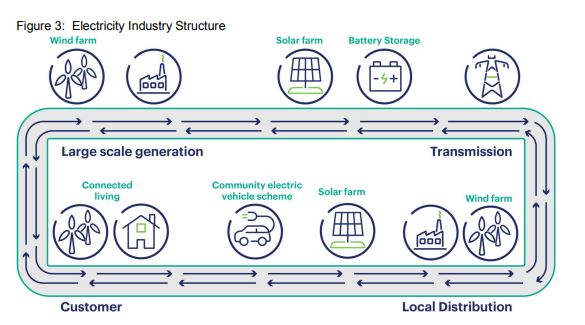
 Be Safe
Be Safe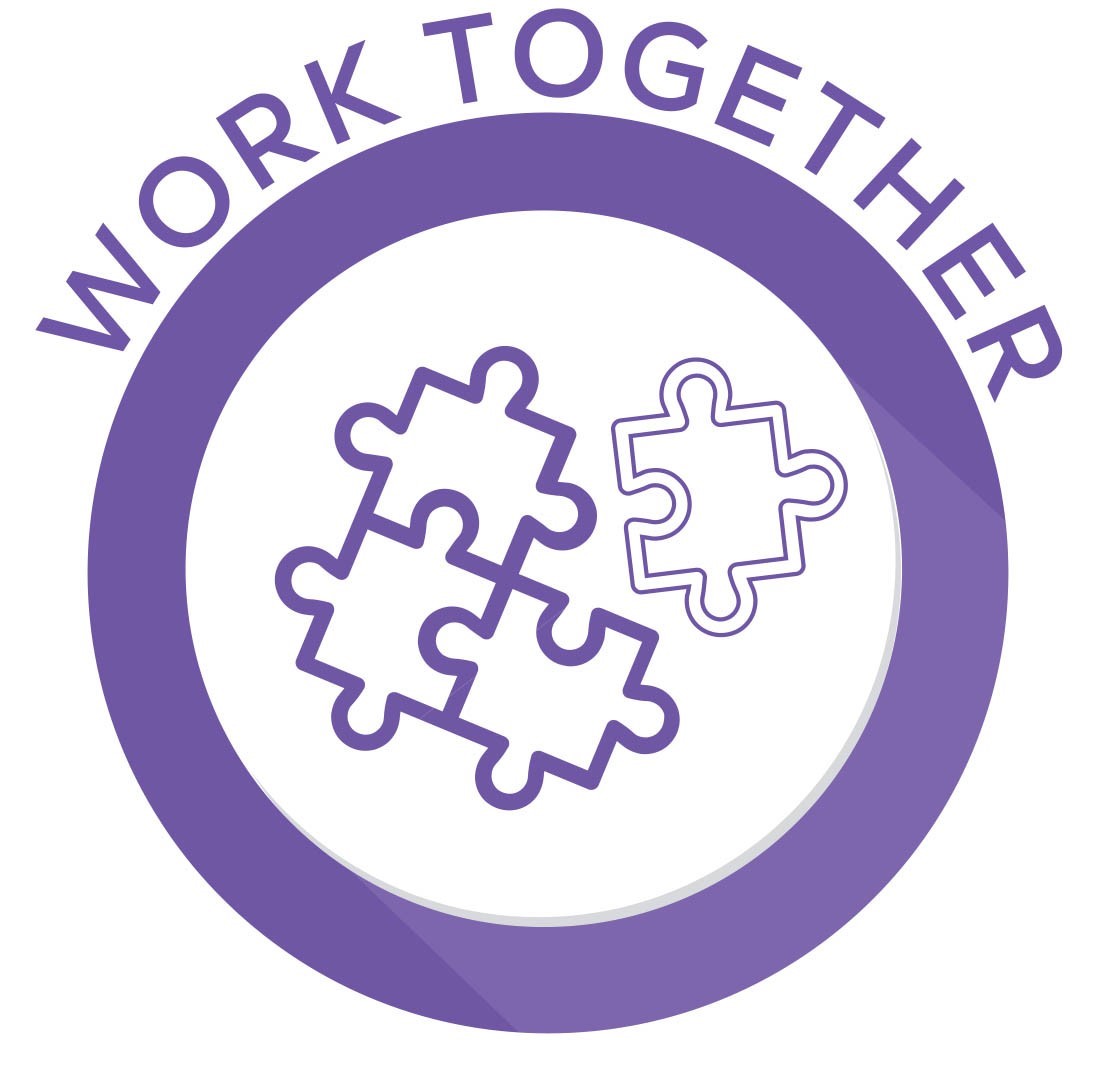 Work Together
Work Together Find a Better Way
Find a Better Way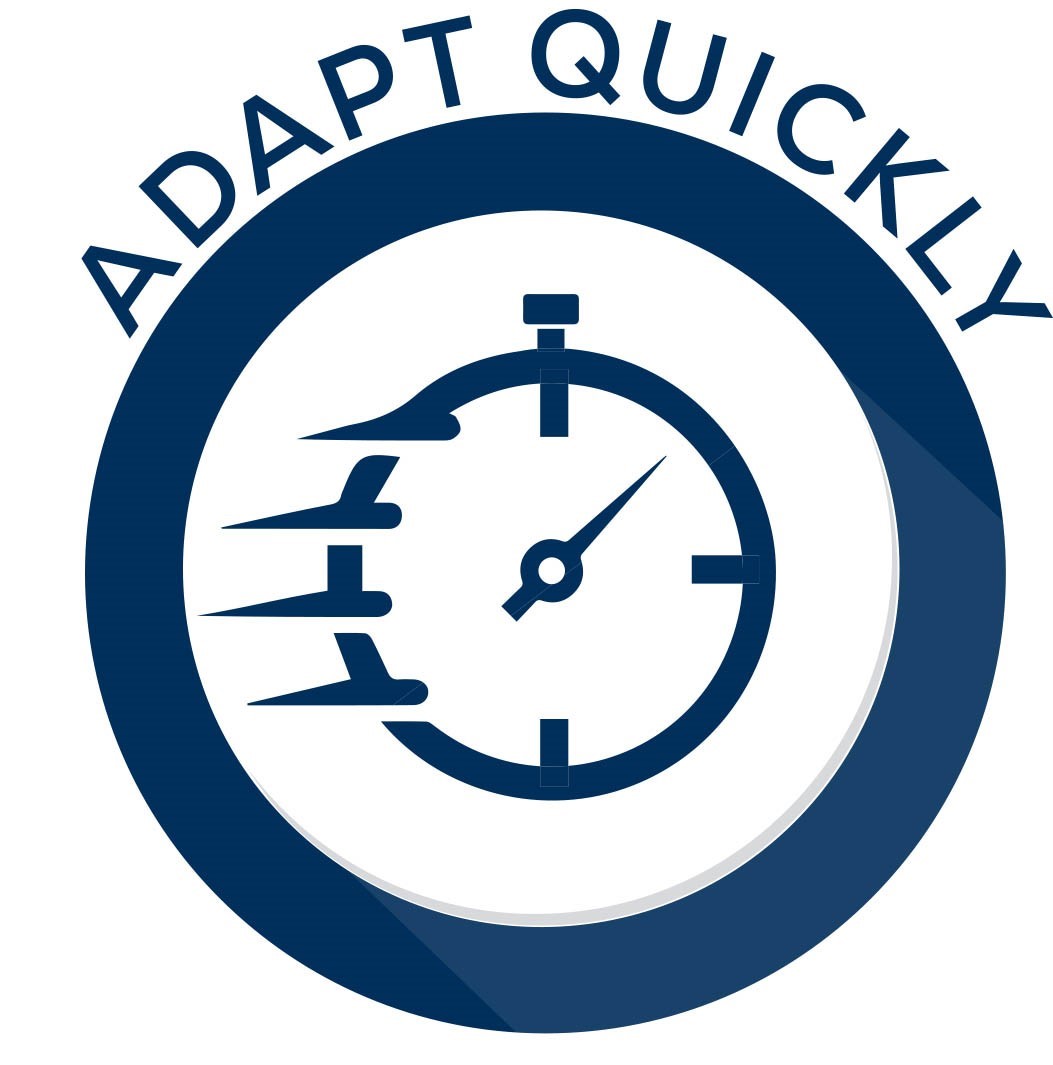 Adapt Quickly
Adapt Quickly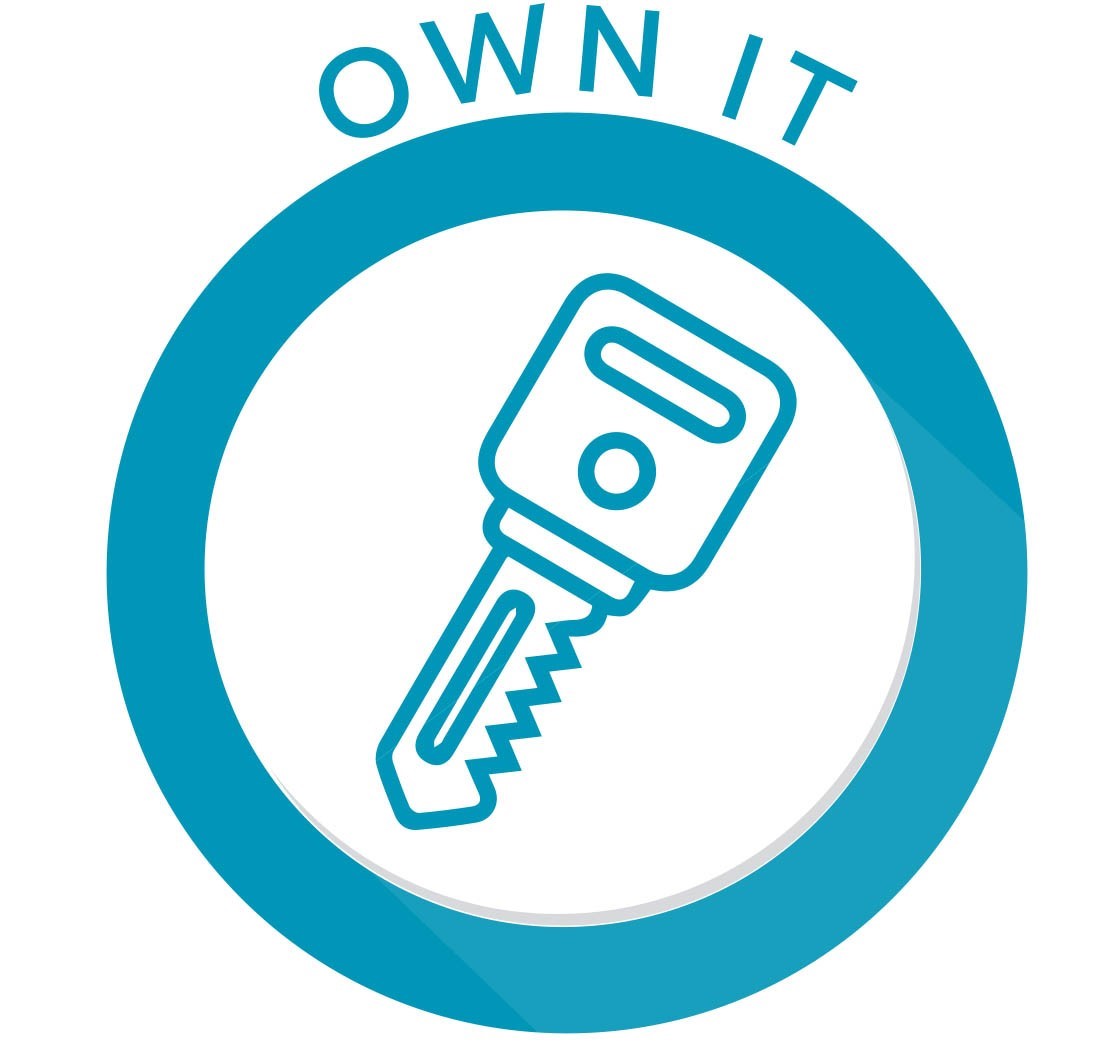 Own It
Own It